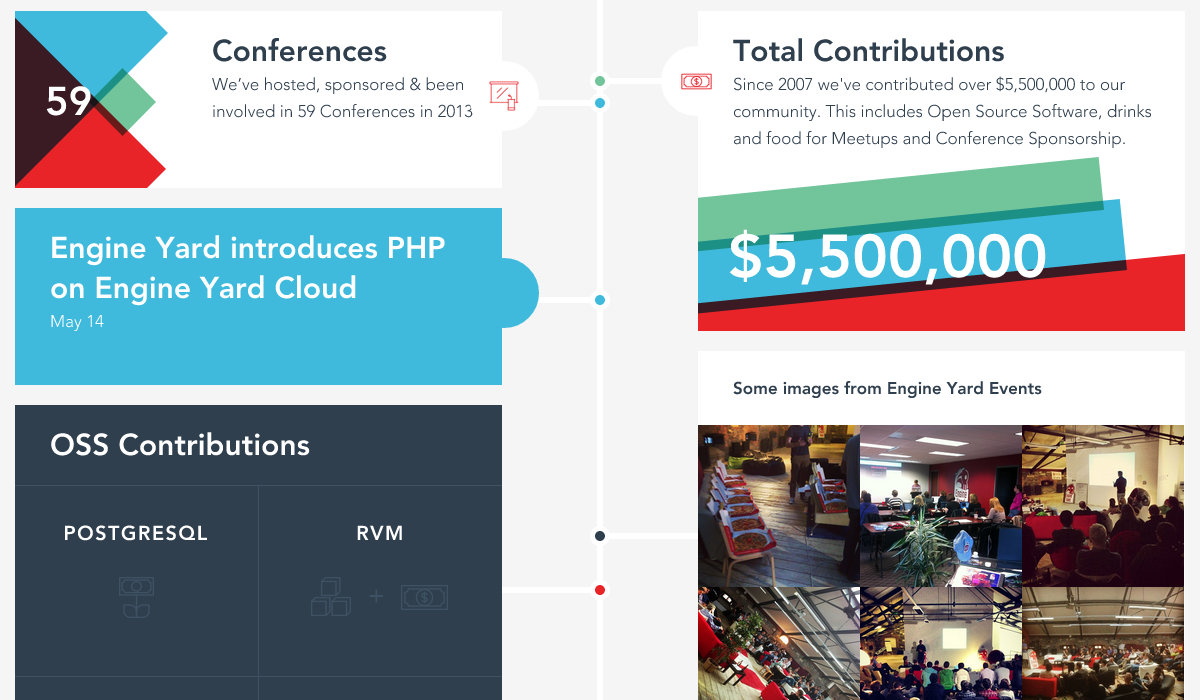Discovering Our Community Work
A few weeks ago, I published a post called An Open Source Grant with a Difference, in which I announced that we are using Gittip to donate $10,000 to the community.
If you haven’t read the post yet, it contains some interesting stuff. I explain what motivated us to use Gittip, especially in how it facilitates our funding goals for this year, and why I think that more people ought to use Gittip in general. The post was received really well.
Many people chose to tweet the following quote:
"In the long term, @engineyard would especially like to focus on those people who are overlooked or marginalised." https://t.co/rs1mcDTimg
— Gratipay (@Gratipay) February 12, 2014This, for me, was one of the core points of the post. I think it’s very important to support people and organisations working on diversity issues. And of course, this is reflected in my choices as to whom to tip. But more than that, I hope to be able to continue to focus on diversity through my work, and to identify and fund other important initiatives. (Stay tuned for more on this!)
One of the other great things in that post was mentioned as an aside, but I’ve been thinking about it a lot since we published it. It’s the fact that since 2007, Engine Yard has contributed over $5,500,000 to the open source community. Be that through employing people to work full time on projects, offering OSS grants, or whatever.
Not only was it the first time we’d published this number, but in fact I only discovered it for myself a few weeks beforehand!
When you come to a company, you want to know how it operates, what its motives are, what the ethics of the company are, and so on. And finding that out is a personal journey.
A Little Archaeology
I’m passionate about open source, and have been working on it for a long time. So of course, when Engine Yard told me I could move from the Product Management team to the Community team and help Engine Yard with its open source contributions, I was over the moon.
For many years, Engine Yard was a Ruby company. And so the wealth of Engine Yard’s contributions have been to the Ruby community. But my background is in CouchDB, Apache, Python, PHP, etc. Not Ruby. So I knew that I had some digging to do.
What I found was scattered across our blog, press releases, our website, other websites, internal documents, emails from colleagues, and so on. But I really wanted to gather it all in one place so that I could truly get an appreciation for it.
One of the things I had heard consistently when talking to people about what we do is that we don’t communicate these things well. That seemed strange to me, especially considering what I had discovered. Engine Yard has been investing heavily in open source since the very beginning. For example, at one point, we had six people working on Rubinius full-time. And this back in the early days, when the company itself was still quite small.
A common belief which kept emerging was that if the community was healthy, the company would be healthy. And so it made clear business sense to invest in the community, and to identify critical projects (like Rubinius) and pieces of infrastructure (like Bundler) and then support them.
(Bundler, as I found out, was actually a spin-off project, originally written by Yehuda Katz at Engine Yard as part of his work on Rails. Merb is another example of something that he worked on for us, later merging it into Rails. Before doing this research, I had had no idea we’d done so much work on Ruby, Ruby on Rails, and other key pieces of the Ruby ecosystem.)
Digging Deeper
Despite all of this, I got the impression I was still missing a lot. So I did an internal survey in January this year. All I did was ask people to list their OSS contributions, so that I might have a better idea of how our staff are contributing individually. When combined with the list of things we have supported as an organisation, the final spreadsheet had 168 rows.
The problem then was how to communicate this. Unless you were already familiar with the history of the Ruby community, which I wasn’t before starting at Engine Yard, a lot of this information was hard to find.
Well, I’m happy to say that I’ve been working with my team on a new community website that we launched last week. We built this so that you don’t have to dig to find the same gold. It’s not perfect—we don’t have even the majority of our minor contributions listed yet—but it’s a start. And we even have a dedicated page about open source.
I also think the timeline is a great centrepiece:
Do have a poke around, and let us know what you think. Is the site okay to navigate? Does it help to communicate our community work? What kind of things are you interested in seeing when you look around it? As developers and designers, we love making things that educate and inform. And we love feedback too! So give us some comments below.


















Share your thoughts with @engineyard on Twitter